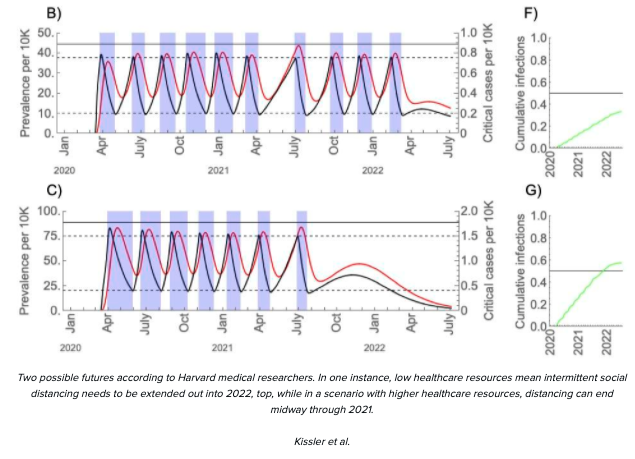Harvard Researchers Propose "Intermittent" Lockdowns And "Widespread Surveillance" Of Americans To Avoid Critical-Care Capacity
Researchers from Harvard's T.H. Chan School of Public Health published a study titled "Social distancing strategies for curbing the COVID-19 epidemic," Tuesday (March 24) on the medRxive pre-print server for health sciences, detailing how a single prolonged widespread lockdown of the country is not the best strategy to combat the COVID-19 pandemic. Instead, the study calls for "intermittent" lockdowns and "widespread surveillance" to mitigate the spread and prevent hospital systems from being overwhelmed.
The study's authors Stephen Iissler, Christine Tedijanto, Marc Lipsitch, and Yonatan Grad of the Chan School said that "a single period of social distancing will not be sufficient." They said without repeated intervals of distancing, "there was a resurgence of infection when the simulated social distancing measures were lifted" in the computer model scenarios.
Keep in mind, as per ZDNet's Tiernan Ray, the study is not yet peer-reviewed, suggesting other scientists have not vetted the computer models of "intermittent" social distancing to solve the virus crisis.
However, the computer models are based on other pandemics and already show that one prolonged lockdown of the country is not the best solution because the virus will return in waves.
The study says some parts of the country where virus cases are low can remain open for business. While other parts that are hard-hit can enforce trict "stay-at-home" public health orders to mitigate the risks of overwhelming hospital systems.
"The SARS-CoV-2 [the virus that causes COVID-19] pandemic is straining healthcare resources worldwide, prompting social distancing measures to reduce transmission intensity," read the study. "The amount of social distancing needed to curb the SARS-CoV-2 epidemic in the context of seasonally varying transmission remains unclear."
The study said the pandemic would likely hit in waves, with the virus subsiding this summer, but could return this fall.
"Using a mathematical model, we assessed that one-time interventions will be insufficient to maintain COVID-19 prevalence within the critical care capacity of the United States. Seasonal variation in transmission will facilitate epidemic control during the summer months but could lead to an intense resurgence in the autumn."
The study concludes by saying, "intermittent distancing measures" on 20-week intervals for specific geographical regions could be turned on and off like a water spigot through 2022.
"Intermittent distancing measures can maintain control of the epidemic, but without other interventions, these measures may be necessary into 2022. Increasing critical care capacity could reduce the duration of the SARS-CoV-2 epidemic while ensuring that critically ill patients receive appropriate care."
As for what determines if an area should be locked down for a 20-week interval is if cases exceed 37.5 cases of the disease per 10,000 adult people in the population. This threshold, the researchers note, would allow health care systems in those regions to maintain an adequate number of hospital beds and ICU-level treatments.
We noted on Friday that governments and corporations are partnering as a collaborative force to employ big data and "widespread surveillance" to monitor if civilians are abiding by social distancing rules. The authors of the study also agreed that surveillance tools are required to monitor the spread and make sure critical care capacity is not being overwhelmed in certain regions.
To sum up, "intermittent" social distancing could become a reality, embraced by the Trump administration to avoid a prolonged depression in the US as much of the economy is shut down at the moment.
https://ift.tt/3dChuNT
from ZeroHedge News https://ift.tt/3dChuNT
via IFTTT





0 comments
Post a Comment